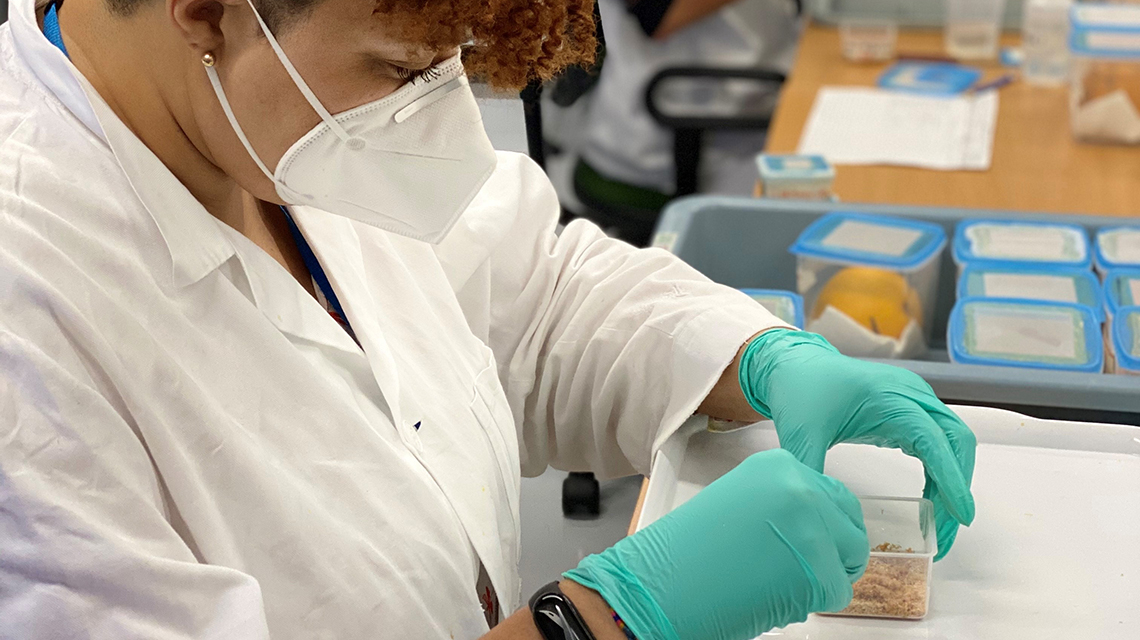Before fresh fruits and vegetables trek across oceans and borders along international trade routes and to the aisles of neighbourhood grocers, they may be treated to eliminate, inactivate or sterilize pests. This highly regulated practice of disinfestation typically involves phytosanitary, or post-harvest treatments, to stop potentially pesky hitchhikers – and is increasingly done using irradiation rather than chemicals.
Phytosanitary Treatments Using Irradiation for Fruit Fly Pests Gain Ground
Female Mexican fruit flies (Anastrepha ludens) prepare to lay eggs into a mango. (Photo: V. Dias/FAO/IAEA)
What are phytosanitary treatments?
Phytosanitary treatments are processes that mitigate biosecurity risks – pests and other non-native organisms – from being introduced and established in pest-free areas. “Heat treatment, irradiation and fumigation are conducted before shipment or upon arrival and are usually done in a matter of hours or less,” said Scott Myers, Assistant Director of Otis Laboratory at the US Department of Agriculture (USDA). “Cold treatments are typically applied in transit, as they take 12 to 22 days to provide efficacy.”
With increasing restrictions placed on the use of chemical fumigants by importing countries, the use of irradiation as a phytosanitary treatment is increasing around the world. It uses ionizing radiation to render pests infertile and “has the benefit of a short treatment time and can maintain the quality of perishable or delicate commodities, such as berries, guavas and figs,” Myers said.
Phytosanitary treatment implementation relies on science-based agreements between trade partners, a process that can take years to establish. The IAEA, in cooperation with the Food and Agriculture Organization of the United Nations (FAO), established a partnership with the USDA in 2010 to conduct research to help trade and health officials establish standards, as well as understand the role of irradiation as a harmless and environmentally friendly option. “The evaluation of phytosanitary treatment efficacy and the proposal of new treatment schedules require access to a large number of colonized insect pest species and specimens, proper equipment and qualified human resources to be conducted,” said Vanessa Dias, an entomologist at the Joint FAO/IAEA Programme of Nuclear Techniques in Food and Agriculture. “We do this and make our results available for experts around the world.”

IAEA intern Inajara Viana Gomes Lima dissects navel oranges for phytosanitary research at the Insect Pest Control Laboratory in Seibersdorf. (Photo: V. Dias/FAO/IAEA)
Advancing phytosanitary treatments
“We maintain colonies of many tropical tephritid fruit fly species and populations from around the world, allowing for unparalleled treatment research against plant quarantine pests,” Dias added. After ten years and an investment of about US $2.7 million from the USDA toward research conducted at the IAEA and FAO, resulting scientific data have led to the approval of eight phytosanitary treatments and an additional seven amendments pending approval from the International Plant Protection Convention.
“This work has supported trade agreements through the production of international standards, and irradiation is increasingly recognized as an enabler for meeting phytosanitary safety requirements,” Dias said. More fresh fruits from Mexico, for example, can be exported to the United States without the risk of spreading invasive pests as a result of the use of this technology. The USDA estimated that exports of fresh guava from Mexico increased by 52 per cent from 2015 to 2017 thanks to the use of phytosanitary irradiation – the only available treatment for this commodity.
Furthermore, in one study, scientists considered uncertainties related to the efficacy of phytosanitary irradiation doses for insects infesting products stored under low oxygen levels, which limited the application of irradiation. “Our results showed that low oxygen treatments applied before and during irradiation did not reduce the efficacy of irradiation protocols for fruit fly pests,” Dias said. “The removal of the restriction to phytosanitary irradiation treatments can increase their applicability and advance the use of nuclear technology for agricultural purposes.”
Through the ongoing partnership with the USDA, research will continue to evaluate the effect of physical and biological factors on the efficacy of phytosanitary treatments and to support the development of future international standards for exporting and importing countries. “This cooperation offers a unique opportunity to develop treatments for a wide range of species and populations. We have been able to not only support USDA treatment schedules but also to facilitate adoption of treatments for inclusion in international standards,” Myers said.
Read more about the IAEA’s work in insect pest control.







